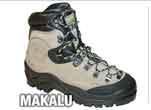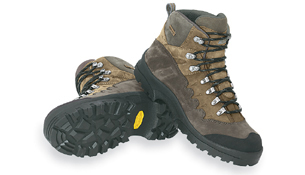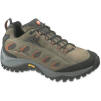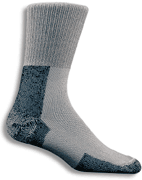 ™
™TRADITIONAL MOUNTAINEERING
™
www.TraditionalMountaineering.org
™ and also
www.AlpineMountaineering.org
™
 ™
™
FREE BASIC TO ADVANCED
ALPINE MOUNTAIN CLIMBING INSTRUCTION™
Home
| Information
| Photos
| Calendar
| News
| Seminars
| Experiences
| Questions
| Updates
| Books
| Conditions
| Links
| Search
![]()
What about boots and shoes?
From an email I received in 2000: I have a question about boots. Do you think that it is best to get plastic boots with step-ins for around here, leather boots that are crampon compatible, or do you need 2-3 kinds of boots? What is your recommendation? I would love to get info on this one.
1. The best strong boots for the long dry approaches and snow climbs on the Oregon Cascades volcanoes are the La Sportiva Makalu.These Italian made La Sportiva boots are crafted of leather tanned with a process that prevents the leather from absorbing water. Forget the lore about covering your boots with heavy petroleum-based lanolin-rich wax "snow seal" and trying to keep your heavy water soaked boots from freezing at night. This lanolin treatment can badly soften the leather and cement. In fact, you will void the warranty from several modern boot makers if you use old-time "waterproofing" techniques.
Use Nikwax water-based (aqueous) products as recommended by the manufacturer. Note: I have recently exchanged emails and phone calls with techs at La Sportiva and Nikwax. They both advise a light coat of "Nikwax Waterproofing Wax for Leather" once a year (only) with periodic touchups with spray-on "Aqueous Wax Leather Waterproofing" to take care of light scuffs.
You must have a boot with a stiff sole for climbing snow: you must be able to kick "flat" steps. Flexible soles will oooch in and can oooch right out. Stiff soles, that are good for walking on forgiving snow, present a problem when walking on a long dry trail approach. The answer is a sole designed with a slight rocker. The Makalu has this feature enabling you to hike in on dry trails and then climb steep hard snow.
You must buy crampons for your winter boots (or boots for your crampons). The Makalu has grooves at the toe and heal that accommodate bomber snap on flexible crampons. I really like GAB crampons made in Germany. They have a scissor feature that assures the side points are lined up with the edges of the boot. Do not put up with unsafe crampons that have points on the ball of the boot that are three quarters of an inch in from the edge. See photos of these boots and crampons.
No single boot model will fit every one's feet. At the Outdoor Retailer's Outdoor Market in Salt Lake City this summer, a Montrail designer told me he "did not design his line to fit my foot, my foot (and a lot of others) just happen to fit Montrails". Just try several brands of the "types" of boots we list here, make sure there is a finger width at the back of your heel before the boots are laced up tight, make sure they are not designed too narrow, that there is plenty of room for the ball of your foot and for your toes. The heel should not be to tight or too sloppy. I prefer a boot that fits big, not tight.
Take your own set of double sox to the store(s). I use thin synthetic Patagonia under-sox for the smooth transfer of sweat and heavy Smartwool "Hiker" outer sox for cushioning. I use the same combination for hot and single digit weather. (As a chairlift operator at Mt. Bachelor a few winters ago, I stood on the snow eight hours a day at all temperatures for two seasons, in my Makalu boots and this sock combination. It works.)
Walk around the house (stay off the kitchen floor!) and be "sure", before you use new boots outdoors. Make sure you can take them back, especially if the store has to order your size. I know this is hard on the smaller retailer, but they must compete with the very big stores. I have switched sizes mail-order from REI, several times without paying excessive shipping. Your boots should fit from the beginning - forget the old time one-season break-in period for heavy imported mountaineering boots, soaking the boots and wearing the wet boots until dry, etc.
If you must get plastic boots, choose the lightest model from a well known manufacturer like La Sportiva of Koflack. Most plastic boots are double boots. You can get double leather boots as well. If you are climbing Denali, do more research.
Recently, Conrad Anker did a report for La Sportiva on using leather boots at high altitude. Unfortunatley, the link is has "left the building".
2. A second boot for summer is the Montrail Gore-Tex model Torre GTX ankle high boot sold by The FootZone in Bend.Many folks believe that an ankle high boot will protect them from sprained ankles. Not so, in my experience. Only the stiffest heavy mountaineering boots designed for ice climbing, high altitude clumping along or tele skiing prevent the ankle from flexing. Any boot you can walk with on a trail, should allow full ankle flexion. What the ankle high boot or shoe will protect you from is a nasty wound on the thin skin of your ankle bone if your foot should slip between rocks, or break a sharp branch.
The real purpose of high lacing on a shoe or boot is to keep your foot from sliding foreword when you are going down hill. The traditional alpine mountaineering stop-break to lace up the boots before starting down, is recognition of this. Many stores have a slanted floor device so that you can test your toe clearance. Folks advocating light low shoes usually won't tell you they have black toe nails!
This boot is breathable with a waterproof/breathable Gore-Tex liner. Periodic touchups with Nikwax aqueous liquid will restore water repellency. It will take care of light scuffs that may appear to wet out a little and it is designed to not obstruct the breathability of the Gore-Tex membrane.
I use these light, ankle high, Gore-Tex boots
for snowshoes. I use the double sox combination detailed above.
3. For light scrambling, backpacking
and easy snow climbing,
I wear the Merrell Reflex Mid Waterproof.
This model laces high enough up the
front to keep your toes back while going down hill. I wear the Thorlo,
"Hiker Thor-lon® Crew" model sox with these shoes. These thick sox never wear out, shrink, tear or lose
their shape. Pretty much, I wear them all the time, stylin' 'round town.
The Merrell Reflex Mid is completely waterproof. Wearing a low OR gaiter assures dry sox after a misstep on a stream crossing. It has an aggressive sole and is a bit higher than most trail shoes. They are heavy and stiff compared with say, the Montrail but they don't slip, keep your feet dry in the rain or hard snow and protect from bruising from running talus or hitting sharp rocks embedded in the trail. See photos of these shoes with light weight Stubai summer crampons
4.
For on-trail hiking and light and fast
backpacking, for the past seven years, I have used the Merrell Radius Gore Tex
Waterproof.
"Uppers feature supple yet supportive and waterproof
nubuck leather with protective rubber toe bumpers and injection-molded heel
counters. Leather bellows tongues provide a superior fit and allow ventilation;
narrow webbing lacing eyelets offer firm instep security. Waterproof laminates
and polyester linings offer waterproof protection and disperse moisture quickly;
taped seams and stitching add protection. Anatomic foot beds offer precision
comfort and moisture management. Compression-molded EVA foot frames with Air
Cushion® heel pockets provide cushioning, stability and durability. Molded nylon
arch shanks supply torsional stability on uneven terrain.
Aggressive Vibram® Multi-Grip™ outsoles feature sticky rubber and deep lugs for
stability and braking on various surfaces."
If you mention TraditionalMountaineering, Teag Hatfield, the owner of The Foot Zone in Bend Oregon, will show you these Montrail and Merrell boots and shoes.
Note: I wrote this page years ago. I
still recommend these same boots and shoes in 2011!
Copyright© 2000-2011 by Robert Speik. All Rights Reserved.
--Robert Speik, TraditionalMountaineering





Mouse over for photo captions!
Vibram | Nikwax | La Sportiva | Montrail | Merrell | Thorlo Socks
![]()
![]()
![]() WARNING - *DISCLAIMER!*
WARNING - *DISCLAIMER!*
Mountain climbing has inherent dangers that can in part, be mitigated!
Read more . . .
American Alpine Club
Oregon Section of the AAC
Accidents in North American Mountaineering
ABOUT TRADITIONAL ALPINE MOUNTAINEERING:
The Sport of Alpine Mountaineering
Climbing Together
Following the Leader
The Mountaineers' Rope
Basic Responsibilities
![]() Cuatro Responsabiliades Basicas de Quienes Salen al Campo
Cuatro Responsabiliades Basicas de Quienes Salen al Campo
The Ten Essential Systems
![]() Los Diez Sistemas Esenciales
Los Diez Sistemas Esenciales
RECENT NEWS POSTINGS
HB 2509 mandates electronic locator beacons on Mt. Hood - climbers' views
![]()
Oregon HB 2509 as approved on March 28, 2007
Three hikers and a dog rescued on Mt. Hood
![]()
Motorist stuck in snow on backcountry Road 18, phones 911 for rescue
Snow stranded Utah couple leave car and die from hypothermia
What happened to the three climbers on Mt. Hood?
![]()
Two climbers become lost descending Mt. Hood
![]()
Missing California family found, dad dies from exposure and hypothermia
![]()
Missing man survives two weeks trapped in snow-covered car
Missing snowmobile riders found, Roger Rouse dies from hypothermia
![]()
Longacre Expeditions teen group rescued from the snowdrifts above Todd Lake
Lost climber hikes 6.5 miles from South Sister Trail to Elk Lake
Young climber stuck on a steep snow slope rescued from Mt. Hood
American Alpine Club's Trad Award goes to Robert Speik in 2006
RECENT EXPERIENCES OF OTHERS
A climb of Three Fingered Jack in the Mount Jefferson Wilderness
Ten high altitude deaths on Everest confirmed for 2006 climbing season
On Being and Becoming a Mountaineer: an Essay
Climbing Mount Hood in April with Arlene Blum and friends
AAC Report - Accident on Mount Washington ends with helicopter rescue
AAC Report - Fatal fall from Three Finger Jack in the Mount Jefferson Wilderness
Three Finger Jack - OSU student falls on steep scree slope
Mount Huntington's West Face by Coley Gentzel
©2005 by AAI. All Rights Reserved
Solo climber falls from Cooper Spur on Mount Hood
Climber dies on the steep snow slopes of Mount McLaughlin
Warning!! **Climbers swept by avalanche while descending North Sister's Thayer Glacier Snowfield
Mt. Whitney's East Face Route is quicker!
Mt. Whitney's Mountaineer's Route requires skill and experience
Report: R.J. Secor seriously injured during a runaway glissade
![]()
Mount Rainer . . . eventually, with R.J. Secor by Tracy Sutkin
Warning!! ** Belayer drops climber off the end of the top rope
Runaway glissade fatal for Mazama climber on Mt. Whitney
Sierra Club climb on Middle Palisade fatal for Brian Reynolds
Smith Rock - Fall on rock, protection pulled out
Mount Washington - Report to the American Alpine Club on a second accident in 2004
Mount Hood - Solo hiker drowns while crossing Mt. Hood's Sandy River
Mount Hood - Solo climber slides into the Bergschrund and is found the following day
Notable mountain climbing accidents analyzed
![]()
Mount Washington - Report to the American Alpine Club on the recent fatal accident
Mount Washington - "Oregon tragedy claims two lives"
Mount Jefferson - two climbers rescued by military helicopter
North Sister - climbing with Allan Throop
TECHNICAL MOUNTAINEERING
What is the best traditional alpine mountaineering summit pack?
What is the best belay | rappel | autoblock device for traditional alpine mountaineering?
What gear do you normally rack on your traditional alpine mountaineering harness?
Photos?
![]()
What is the best traditional alpine mountaineering seat harness?
Photos?
Can I use a Sharpie Pen for Marking the Middle of the Climbing Rope?
What are the highest peaks in Oregon?
Alphabetically?
CARBORATION AND HYDRATION
Is running the Western States 100 part of "traditional mountaineering"?
What's wrong with GORP?
Answers to the quiz!
Why do I need to count carbohydrate calories?
What should I know about having a big freeze-dried dinner?
What about carbo-ration and fluid replacement during traditional alpine climbing?
4 pages in pdf
![]()
What should I eat before a day of alpine climbing?
ALPINE CLIMBING ON SNOW AND ICE
Man rescued from crevasse just off South Sister climber's trail
Winter mountaineering hazards - streams and lakes
Is long distance backpacking part of "traditional mountaineering"?
How long is the traditional alpine mountaineering ice axe?
What about climbing Mt. Hood?
What is a good personal description of the south side route on Mount Hood?
What should I know about travel over hard snow and ice?
Why do you like GAB crampons for traditional mountaineering?
Which crampons are the best?
What about Boots and Shoes?
![]()
AVALANCHE AVOIDANCE
The latest avalanche victim was only 13
Climbers swept by avalanche while descending North Sister's Thayer Glacier Snowfield
![]()
Snowshoer dies in backcountry avalanche in Washington State
Young Bend man dies in back county avalanche
What is an avalanche cord?
Avalanche training courses - understanding avalanche risk
How is avalanche risk described and rated by the professionals?
pdf table
How can I avoid dying in an avalanche?
Known avalanche slopes near Bend, OR?
What is a PLB?
Can I avoid avalanche risk with good gear and seminars?
pdf file
SNOWSHOES AND CRAMPONS
What are technical snowshoes?
What should I know about the new snowshoe trails
The snow shoe shuffle race
Snowcamping offers rewarding adventure
Snowshoes keeping up with the times
Snowshoe trail tips
Technical snowshoes
Snowshoe touring techniques for the backcountry
Snowshoer dies in backcountry avalanche in Washington State
Snowshoe tours with Forrest Service volunteers
What should I know about travel over hard snow and ice?
Why do you like GAB crampons for traditional mountaineering?
Which crampons are the best?
What about Boots and Shoes?
![]()
YOUR ESSENTIAL SUMMIT PACK
What are the new Ten Essential Systems?
What does experience tell us about Light and Fast climbing?
What is the best traditional alpine mountaineering summit pack?
What is Light and Fast alpine climbing?
What do you carry in your day pack?
Photos?
![]()
What do you carry in your winter day pack?
Photos?
![]()
What should I know about "space blankets"?
Where can I get a personal and a group first aid kit?
Photos?
YOUR LITE AND FAST
OVERNIGHT BACKPACK
Which light backpack do you use for winter and summer?
Analysis
pdf
![]()
What would you carry in your backpack to climb Shasta or Adams?
![]()
What is the best traditional alpine mountaineering summit pack?
Photos of lite gear packed for a multi day approach to spring and summer summits
Backpack lite gear list for spring and summer alpine mountaineering
4 pdf pages
ESSENTIAL PERSONAL GEAR
What does Steve House wear for light and fast climbing?
What clothing do you wear for Light and Fast winter mountaineering?
What do you carry in your winter day pack?
Photos?
![]()
Which digital camera do you use in the mountains?
What about Boots and Shoes?
![]()
TRADITIONAL KNOWLEDGE
How did you become interested in traditional mountaineering techniques?
Who is Conrad Messner?
What is traditional slacklining or highlining?
What are some of the comments you have received?
Who was Peter Starr?
Who are the Mazamas?
What is an avalanche cord?
Who were the notorious Vulgarians?
How was top rope climbing practiced in the 1970s?
What is a Whillans sit harness?
What is a dulfersitz rappel?
How do I self-belay a rappel?
BACKCOUNTRY NAVIGATION
How accurate is the inexpensive hand-held GPS today?
Can you get me a $30 rebate on your favorite GPS: Garmin's Legend?
pdf form
What are some good Central Oregon Geocaches?
What is the Public Land Survey Grid?
pdf
What is the UTM Grid?
six pdf pages
Which GPS do you like?
![]()
Which Compass do you like?
![]()
How do you use your map, compass and GPS together, in a nut shell?
How can I learn to use my map, compass and GPS?
Do you have map, compass and GPS seminar notes?
six pdf pages
![]() Search this site!
Search this site!
Copy and paste these search suggestions for more views of the Cascades
North Sister
Middle Sister
South Sister
Broken Top